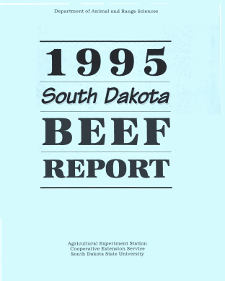Document Type
Report
Report Number
95-8
Publication Date
1995
Keywords
intake level, energy partitioning, genotype, beef cow
Summary
Mature Angus-Hereford (AH; n = 15) and Simmental-Hereford (SH; n = 16) cows were used to evaluate the effects of adaptation to moderate (adequate to at least maintain body condition) and low (76% of moderate) intakes on feed energy partitioning by cows of different genotypes. Cows were fed individually in drylot for one complete production cycle (1 2 months). Conventional energy balance techniques and respiration calorimetry were used once during gestation and twice during lactation to evaluate energy utilization. Condition scores differed by .7 units (5.0 vs 4.3; P< .001) between intake levels by the end of the study. Heat production at 195 days of gestation was affected by intake level (P< .001) but not by genotype (P> .20), and there was no interaction between the main effects (Gxl P>.20). During lactation measurements, milk energy production did not differ between genotypes and intake levels (P> .15). However, heat productions for AH and SH cows adapted to the low intake were 12% and 7% less than AH and SH adapted to the moderate intake, respectively (Gxl P < .05). Additionally, deposition of tissue energy was reduced 20% and 39% by low intake AH and SH cows relative to moderate intake AH and SH cows, respectively (Gxl P < .06). The results are interpreted to indicate that genotypes traditionally selected for greater milk production rely more on tissue energy adjustment to support milk production than on reduction of metabolic rate (maintenance).
Number of Pages
3
Format
application/pdf
Language
en
Publisher
South Dakota State University
Rights
Copyright © 1995 South Dakota State University.
Recommended Citation
Birkelo, C. P.; Freking, B. M.; and Marshall, D. M., "Energetic Response of Angus and Simmental Crossbred Cows to Low and Moderate Intakes" (1995). South Dakota Beef Report, 1995. 9.
https://openprairie.sdstate.edu/sd_beefreport_1995/9

